Popular categories
Looking for a yarn?

65% Wool, 35% Alpaca
from 3.30 $ /50g
The yarn cost is calculated from the pattern’s smallest size and the yarn’s cheapest product type. Looking for an even better price? You might find it on the DROPS Deals!
Enchanted
Knitted DROPS jacket with False English rib and short rows in "Nepal". Size S-XXXL
DROPS design: Pattern no ne-149
Yarn group C or A + A
-----------------------------------------------------------
Size: S - M - L - XL - XXL - XXXL
Finished measurements:
Bust: 78-88-92-104-114-128 cm / 30 3/4"-34½"-36"-41"-45"-50½"
Full length: 59-62-65-68-72-77 cm / 23¼''-24½''-25½''-26¾''-28½''-30½''
Materials:
DROPS NEPAL from Garnstudio
650-700-750-850-950-1000 g color no 0500, light gray
DROPS CIRCULAR NEEDLE (60 or 80 cm / 24'' or 32'') SIZE 5 mm / US 8 – or size needed to get 17 sts x 22 rows in stockinette st = 4'' x 4'' (10 x 10 cm).
DROPS MOTHER-OF-PEARL BUTTON NO 522: 5 pieces for all sizes
-------------------------------------------------------
Alternative Yarn – See how to change yarns here
Yarn Groups A to F – Use the same pattern and change the yarn here
Yarn usage using an alternative yarn – Use our yarn converter here
-------------------------------------------------------

65% Wool, 35% Alpaca
from 3.30 $ /50g
The yarn cost is calculated from the pattern’s smallest size and the yarn’s cheapest product type. Looking for an even better price? You might find it on the DROPS Deals!
- English (US/in)
- Česky - not translated
- Dansk
- Deutsch
- Eesti keel
- English (UK/cm)
- Español
- Français
- Íslenska
- Italiano
- Magyar
- Nederlands
- Norsk
- Polski
- Português
- Suomi
- Svenska
- English (UK/cm), Bulgaria
- English (UK/cm), Croatia
- English (UK/cm), Greece
- English (UK/cm), Latvia
- English (UK/cm), Lithuania
- English (UK/cm), Romania
- English (UK/cm), Slovenia
- Česky, Slovakia - not translated
Pattern instructions
K all rows. 1 ridge = K2 rows.
PATTERN:
See diagrams A.1-A.3. The diagram shows all rows in pattern seen from RS.
INCREASE TIP (applies to sleeve):
Inc inside 1 edge st in garter st and 1 P by making 1 YO. On next round work YO twisted, i.e. work in the back loop of st instead of front, to avoid holes.
DECREASE TIP:
Dec inside 1 edge st in garter st. All dec are done from RS!
Dec before 1 edge st as follows: K 2 tog.
Dec after 1 edge st as follows: Slip 1 st as if to K, K 1, psso.
SHORT ROWS:
Work short rows on front piece to get a rounded edge on the piece. Also work short rows between pattern A.2/A.3!
Work short rows as follows with 1st row from RS:
Row 1 and 2: Work 8 sts in all sizes, turn and work back.
Row 3 and 4: Work 12 sts in all sizes, turn and work back.
Row 5 and 6: Work 16 sts in all sizes, turn and work back.
Row 7 and 8: Work 19-19-20-20-19-20 sts, turn and work back.
Row 9 and 10: Work 21-21-23-23-21-23 sts, turn and work back.
Continue to work 3 sts more on every turn until all sts have been worked.
Repeat from 1st row a total of 5 times. (The rounded edge now measures approx. 28-31-34-37-41-46 cm / 11''-12¼''-13 3/8''-14½''-16''-18'' on the outer side and 3 cm / 1'' on the inside.)
BUTTONHOLES:
Dec for buttonholes on right band. 1 buttonhole = K tog second and third st from mid front and make 1 YO.
Dec for buttonholes when piece measures (measured from the marker in the side):
SIZE S: 1-8-15-22-29 cm / ½''-3''-6''-8¾''-11½''
SIZE M: 1-8-15-22-30 cm / ½''-3''-6''-8¾''-11¾''
SIZE L: 1-8-15-22-30 cm / ½''-3''-6''-8¾''-11¾''
SIZE XL: 1-8-16-23-31 cm / ½''-3''-6¼''-9''-12¼''
SIZE XXL: 1-8-16-23-31 cm / ½''-3''-6¼''-9''-12¼''
SIZE XXXL: 1-9-17-25-32 cm / ½''-3½''-6¾''-9¾''-12½''
----------------------------------------------------------
JACKET:
Worked back and forth in parts on circular needle and sewn tog when finished.
BACK PIECE:
Cast on 63-71-75-83-91-103 sts (includes 1 edge st in garter st in each side) on circular needle size 5 mm / US 8 with Nepal. Work 1 ridge in GARTER ST - see explanation above. Then work as follows: 1 edge st in garter st, A.1 (= 4 sts) until 2 sts remain on row, work 1st st in A.1, 1 edge st in garter st. Continue like this with pattern, AT THE SAME TIME when piece measures 4 cm / 1½'', inc inside 1 edge st in garter st in each side of piece by making 1 YO. On next row work YOs twisted to avoid holes, then P the new sts (seen from RS)! Repeat inc every 4-4-4-3-3-3 cm / 1½''-1½''-1½''-1¼''-1¼''-1¼'' 2-2-2-3-3-3 more times = 69-77-81-91-99-111 sts. REMEMBER THE GAUGE!
When piece measures 20 cm / 8'' in all sizes, bind off for armholes each side as follows: bind off 3-4-5-6-7-8 sts 1 time and 1 st 1-3-3-6-7-11 times = 61-63-65-67-71-73 sts. Continue with pattern as before until piece measures 37-38-39-40-41-42 cm / 14½''-15''-15¼''-15¾''-16 1/8''-16½''. On next row from RS bind off for neck as follows: Work the first 21-22-22-23-24-25 sts, bind off the next 19-19-21-21-23-23 sts and work the remaining 21-22-22-23-24-25 sts. Then finish each shoulder separately as follows: Continue back over left shoulder and dec 1 st towards the neck on next row from RS = 20-21-21-22-23-24 sts for shoulder. When piece measures 38-39-40-41-42-43 cm / 15-15¼''-15¾''-16 1/8''-16½''-17'', work 1 ridge and loosely bind off. Work the other shoulder the same way.
RIGHT EDGE PIECE/FRONT PIECE:
Cast on 35-38-42-45-50-57 sts (includes 1 edge st in garter st) on circular needle size 5 mm / US 8 with Nepal. Work 1 ridge in garter st. Then work as follows from RS: Pattern A.3 (= 18 sts), 16-19-23-26-31-38 sts in garter st, 1 edge st in garter st. When piece measures approx. 18-21-23-24-26-30 cm / 7''-8¼''-9''-9½''-10¼''-11¾'', work SHORT ROWS - see explanation above, AT THE SAME TIME on last row in 1st repetition with short rows, inc 1 st by making a YO between A.3 and sts in garter st = 36-39-43-46-51-58 sts. Work YOs twisted on next row to avoid holes. Repeat inc on last row in the remaining repetitions of short rows 3-4-1-2-0-0 more times = 39-43-44-48-51-58 sts on needle. When all short rows have been worked, insert 1 marker. NOW MEASURE PIECE FROM HERE! Continue with garter st and pattern as before. Remember BUTTONHOLES - see explanation above. When piece measures 4 cm / 1½'', inc in the side as on back piece (i.e. the shorter side). After all inc, there are 42-46-47-52-55-62 sts on needle. When piece measures 20 cm / 8'', bind off for armhole in the side as on back piece (i.e in same side of piece as inc) = 38-39-39-40-41-43 sts.
When piece measures 30-31-31-32-32-33 cm / 11¾''-12¼''-12¼''-12½''-12½''-13'', slip the first 9 sts on needle from RS on a stitch holder for neck. Then bind off sts as follows on every row from neck: 3 sts 1 time, 2 sts 2 times and 1 st 2 times = 20-21-21-22-23-25 sts remain for shoulder. When piece measures 38-39-40-41-42-43 cm / 15-15¼''-15¾''-16 1/8''-16½''-17'', work 1 ridge and bind off.
LEFT EDGE PIECE/FRONT PIECE:
Cast on and work as right edge piece/front piece but reversed. I.e. K 1 row from WS before working pattern like this: 1 edge st in garter st, 16-19-23-26-31-38 sts in garter st, A.2 over the remaining 18 sts on needle. Do not dec for buttonholes.
SLEEVE:
Worked back and forth on circular needle in reversed stockinette st.
Cast on 42-42-44-44-46-48 sts (includes 1 edge st each side) on needle size 5 mm / US 8 with Nepal. Work 10 cm / 4'' in garter st. Continue with reversed stockinette st. On next row inc 1 st in each side of sleeve - Read INCREASE TIP! Repeat inc every 4-3-3-2½-2-2 cm / 1½''-1¼''-1¼''-1''-¾''-¾'' 8-10-10-12-13-14 more times = 60-64-66-70-74-78 sts. When piece measures 50-49-48-47-46-45 cm / 19¾''-19¼''-19''-18½''-18''-17¾'' (shorter measurements in the larger sizes because of longer sleeve cap and wider shoulders) bind off for sleeve cap at beg of every row in each side: 3 sts 1 time, 2 sts 3 times and 1 st 1-2-3-4-5-6 times, then bind off 2 sts in each side until piece measures 57 cm / 22½'', then bind off 3 sts 1 time in each side, bind off remaining sts. Piece measures approx. 58 cm / 22¾''. Make another sleeve.
ASSEMBLY:
Sew cast on edge on edge pieces tog mid back - sew edge to edge to avoid a chunky seam. Then sew edge piece to bottom edge of back piece. Sew the shoulder seams. Sew side seams and sleeve seams inside 1 edge st and sew sleeves in body. Sew the buttons on to the left band.
NECK EDGE:
Pick up approx. 72 sts (includes sts on stitch holders) around the neck. Work 2 ridges and bind off from WS. Cut and fasten the yarn.
Diagram
All measurements in charts are in cm.

|
= K from RS, P from WS |

|
= P from RS, K from WS |

|
= 1 YO, slip 1 st as if to P |

|
= P YO and st tog |

|
= knitting direction |

|
= beg here on left front/back piece |
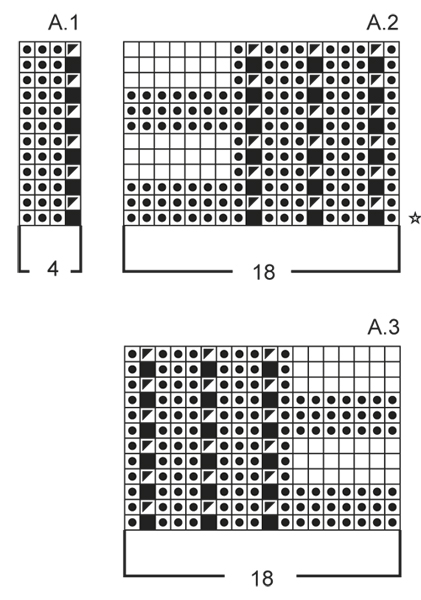
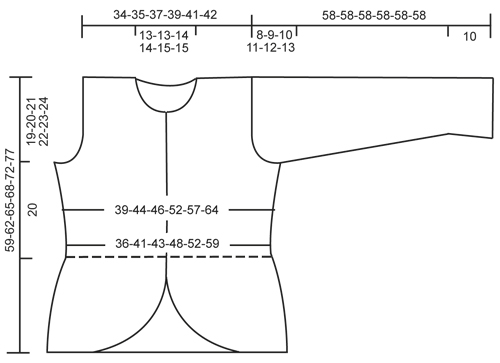
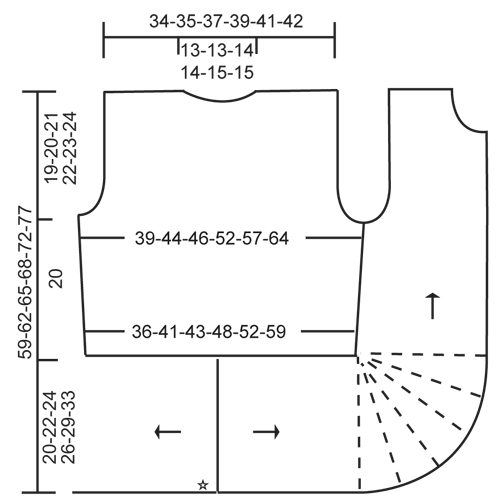
What can you do with our patterns? You can share DROPS patterns online, using the pattern original picture, materials, name and number. But you are NOT ALLOWED to reproduce the complete pattern digitally in any way. Yarn stores are welcome to use the DROPS pattern database to promote the sale of our assortment. You can print out our patterns, make as many copies as you’d like. The only thing we ask is that you don't make any changes / additions to the original printed document. And that the patterns according to the DROPS philosophy are given out to the consumers for free. Editorials that wish to publish our patterns in printed books or magazines can contact us for more information. The sale of garments based on DROPS patterns is permitted as long as they are sold as single items or per order. Further commercial use of the patterns is not permitted. It has to be clearly stated that the garment is made based on a design from DROPS DESIGN. The use of clothing labels of which DROPS DESIGN forms part is conditioned by the inclusion of the following text: “A DROPS DESIGN made by …..”. The use of DROPS photos for marketing purposes/sales is only permitted in connection with the use/sale of DROPS products. The photos may not be cut or edited and the logo should be clearly visible.
We reserve the right to withdraw the permission for use of our patterns at any time, notwithstanding the reason.
Each of our patterns has specific tutorial videos to help you.
These step-by-step tutorials might also help you:
Why is the knitting/crochet tension so important?
Knitting tension is what determines the final measurements of your work, and is usually measured per 10 x 10 cm. It is provided like so: number of stitches in width x number of rows in height - eg: 19 stitches x 26 rows = 10 x 10 cm.
The knitting tension is very individual; some people knit/crochet loosely while others work tightly. You adjust the knitting tension with the needle size, which is why the suggested needle size only serve as a guide! You need to adjust this (up or down) to ensure that YOUR knitting tension matches the knitting tension provided in the pattern. If you work with a different knitting tension than provided you will have a different yarn consumption, and your work will have different measurements than what the pattern suggests.
The knitting tension also determines which yarns can replace each other. As long as you achieve the same knitting tension you can replace one yarn with another.
See DROPS lesson: How to measure your tension/gauge
See DROPS video: How to make a gauge tension swatch
How do I know how many balls of yarn I need?
The required amount of yarn is provided in grams, eg: 450 g. To calculate how many balls you’ll need you first need to know how many grams are in 1 ball (25g, 50g or 100g). This information is available if you click on the individual yarn quality on our pages. Divide the amount required with the amount of each ball. For example, if each ball is 50g (the most common amount), the calculation will be as follows: 450 / 50 = 9 balls.
Can I use a different yarn than what the pattern suggests?
The important thing when changing from one yarn to another is that the knitting/crochet tension remains the same. This is so that the measurements of the finished piece will be the same as on the sketch provided. It is easier to achieve the same knitting tension using yarns from the same yarn group. It is also possible to work with multiple strands of a thinner yarn to achieve the knitting tension of a thicker one. Please try our yarn converter. We recommend you to always work a test swatch.
Please NOTE: when changing yarn the garment might have a different look and feel to the garment in the photo, due to individual properties and qualities of each yarn.
See DROPS lesson: Can I use a different yarn than the one mentioned in the pattern?
What are the yarn groups?
All our yarns are categorised into yarn groups (from A to F) according to thickness and knitting tension – group A contains the thinnest yarns and group F the thickest. This makes it easier for you to find alternative yarns to our patterns, should you wish to switch yarn. All yarns within the same group have a similar knitting tension and can easily replace each other. However, different yarn qualities have different structures and properties which will give the finished work a unique look and feel.
How do I use the yarn converter?
At the top of all our patterns you’ll find a link to our yarn converter, which is a helpful tool should you wish to use a different yarn than suggested. By filling in the yarn quality you wish to replace, the amount (in your size) and number of strands, the converter will present good alternative yarns with the same knitting tension. Additionally it will tell you how much you’ll require in the new qualities and whether you’ll need to work with multiple strands. Most skeins are 50g (some are 25g or 100g).
If the pattern is worked with multiple colours, every colour will have to be converted separately. Similarly, if the pattern is worked with several strands of different yarns (for example 1 strand Alpaca and 1 strand Kid-Silk) you will have to find alternatives for each, individually.
Why do you show discontinued yarns in the patterns?
Since different yarns have different qualities and textures we have chosen to keep the original yarn in our patterns. However, you can easily find options among our available qualities by using our yarn converter, or simply pick a yarn from the same yarn group.
It is possible that some retailers still have discontinued yarns in stock, or that someone has a few skeins at home that they would like to find patterns for.
The yarn converter will provide both alternative yarn as well as required amount in the new quality.
What size should I knit?
If you think it's hard to decide what size to make, it can be a good idea to measure a garment you own already and like the size of. Then you can pick the size by comparing those measures with the ones available in the pattern's size chart.
You'll find the size chart at the bottom of the pattern.
See DROPS lesson: How to read size chart
Why do I get the wrong knitting tension with the suggested needle size?
The needle size provided in the pattern serves only as a guide, the important thing is to follow the knitting tension. And since knitting tension is very individual, you will have to adjust the needle size to ensure that YOUR tension is the same as in the pattern – maybe you’ll have to adjust 1, or even 2 needle sizes, up or down to achieve the correct tension. For this, we recommend that you work test swatches.
Should you work with a different knitting tension than the one provided, the measurements of the finished garment might deviate from the measurement sketch.
See DROPS lesson: How to measure your tension/gauge
See DROPS video: How to make a gauge tension swatch
Why is the pattern worked top-down?
Working a garment top-down provides more flexibility and room for personal adjustment. For example it is easier to try the garment on while working, as well as making adjustments to length of yoke and shoulder caps.
The instructions are carefully explaining every step, in the correct order. Diagrams are adjusted to the knitting direction and are worked as usual.
How do I work according to a knitting diagram?
The diagram depicts all rows/rounds, and every stitch seen from the right side. It is read from bottom to top, from right to left. 1 square = 1 stitch.
When working back and forth, every other row is worked from the right side and every other row is worked from the wrong side. When working from the wrong side, the diagram will have to be worked reversed: from left to right, knit stitches are purled, purl stitches are knit etc.
When working in the round every round is worked from the right side and the diagram are worked from right to left on all rounds.
See DROPS lesson: How to read knitting diagrams
How do I work according to a crochet diagram?
The diagram depicts all rows/rounds, and every stitch seen from the right side. It is worked from bottom to top, from right to left.
When working back and forth every other row is worked from the right side: from right to left and every other row is worked from the wrong side: from left to right.
When working in the round, every row in the diagram are worked from the right side, from right to left.
When working a circular diagram you start in the middle and work your way outwards, counter clockwise, row by row.
The rows usually start with a given number of chain stitches (equivalent to the height of the following stitch), this will either be depicted in the diagram or explained in the pattern.
See DROPS lesson: How to read crochet diagrams
How do I work several diagrams simultaneously on the same row/round?
Instructions for working several diagrams after each other on the same row/round, will often be written like so: “work A.1, A.2, A.3 a total of 0-0-2-3-4 times". This means you work A.1 once, then A.2 is worked once, and A.3 is repeated (in width) the number of times provided for your size – in this case like so: S = 0 times, M = 0 times, L=2 times, XL= 3 times and XXL = 4 times.
The diagrams are worked as usual: begin with the first row in A.1, then work the first row in A.2 etc.
See DROPS lesson: How to read knitting diagrams
See DROPS lesson: How to read crochet diagrams
Why are the sleeves shorter in larger sizes?
The total width of the garment (from wrist-to-wrist) will be larger in the larger sizes, despite the actual sleeves being shorter. The larger sizes have longer sleeve caps and wider shoulders, so there will be a good fit in all sizes.
Where on the garment is the length measured?
The measurement sketch/schematic drawing provides information regarding the full length of the garment. If it’s a jumper or a jacket the length is measured from the highest point on the shoulder (usually closest to the neckline), and straight down to the bottom of the garment. It is NOT measured from the tip of shoulder. Similarly, the length of yoke is measured from the highest point on the shoulder and down to where yoke is split into body and sleeves.
See DROPS lesson: How to read a schematic drawing
What is a repeat?
Diagrams are often repeated on the round or in height. 1 repeat is the diagram the way it appears in the pattern. If it says to work 5 repeats of A.1 in the round, then you work A.1 a total of 5 times after/next to each other in the round. If it says to work 2 repeats of A.1 vertically/in height you work the entire diagram once, then begin again at the start and work the entire diagram one more time.
Why does the piece start with more chain stitches than it’s worked with?
Chain stitches are slightly narrower than other stitches and to avoid working the cast-on edge too tight, we simply chain more stitches to begin with. The stitch count will be adjusted on the following row to fit the pattern and measurement sketch.
Why increase before the rib edge when the piece is worked top-down?
The rib edge is more elastic and will contract slightly compared to, for example, stocking stitch. By increasing before the rib edge, you avoid a visible difference in width between the rib edge and the rest of the body.
Why increase in the cast-off edge?
It’s very easy to cast off too tightly, and by making yarn overs while casting off (and simultaneously casting these off) you avoid a too tight cast off edge.
See DROPS video: How to bind off with yarn overs (yo)
How do I increase/decrease on every 3rd and 4th row/round alternately?
To achieve an even increase (or decrease) you can increase on, for example: every 3rd and 4th row alternately, like so: work 2 rows and increase on the 3rd row, work 3 rows and increase on the 4th. Repeat this until the increase is complete.
See DROPS lesson: Increase or decrease 1 st on every 3rd and 4th row alternately
How can I work a jacket in the round instead of back and forth?
Should you prefer to work in the round instead of back and forth, you may of course adjust the pattern. You’ll need to add steeks mid-front (usually 5 stitches), and follow the instructions. When you would normally turn and work from the wrong side, simply work across the steek and continue in the round. At the end you’ll cut the piece open, pick up stitches to work bands, and cover the cut edges.
See DROPS video: How to knit steeks and cut open
Can I work a jumper back and forth instead of in the round?
Should you prefer to work back and forth instead of in the round, you may of course adjust the pattern so you work the pieces separately and then assemble them at the end. Divide the stitches for the body in 2, add 1 edge stitch in each side (for sewing) and work the front and back pieces separately.
See DROPS lesson: Can I adapt a pattern for circular needles into straight needles?
Why is the pattern slightly different than what I see in the photo?
Pattern repeats can vary slightly in the different sizes, in order to get the correct proportions. If you’re not working the exact same size as the garment in the photo, yours might deviate slightly. This has been carefully developed and adjusted so that the complete impression of the garment is the same in all sizes.
Make sure to follow instructions and diagrams for your size!
How do I make a women’s size garment into a men’s size one?
If you have found a pattern you like which is available in women’s size it’s not very difficult to convert it to men’s size. The biggest difference will be the length of sleeves and body. Start working on the women size that you think would fit across the chest. The additional length will be worked right before you cast off for the armhole/sleeve cap. If the pattern is worked top-down you can add the length right after the armhole or before the first decrease on sleeve.
Regarding additional yarn amount, this will depend on how much length you add, but it is better with a skein too many than too few.
How do I prevent a hairy garment from shedding?
All yarns will have excess fibres (from production) that might come off as lint or shedding. Brushed yarns (ie hairier yarns) have more of these loose, excess fibres, causing more shedding.
Shedding also depends on what is worn under or over the garment, and whether this pulls at the yarn fibres. It’s therefore not possible to guarantee that there will be no shedding
Below are some tips on how to get the best result when working with hairier yarns:
1. When the garment is finished (before you wash it) shake it vigorously so the looser hairs come off. NOTE: do NOT use a lint roller, brush or any method that pulls at the yarn.
2. Place the garment in a plastic bag and put it in your freezer - the temperature will cause the fibres to become less attached to each other, and excess fibres will come off easier.
3. Leave in the freezer for a few hours before taking it out and shaking it again.
4. Wash the garment according to the instructions on the yarn label.
Why does my garment pill?
Pilling is a natural process that happens to even the most exclusive of fibers. It's a natural sign of wear and tear that is hard to avoid, and that is most visible in high friction areas of your garment like a sweater's arms and cuffs.
You can make your garment look as new by removing the pilling, using a fabric comb or a pill/lint remover.
In the meantime, you can read the questions and answers that others have left to this pattern or join the DROPS Workshop on Facebook to get help from fellow knitters/crocheters!
You might also like...
Enchanted |
|||||||||||||||||||
 |
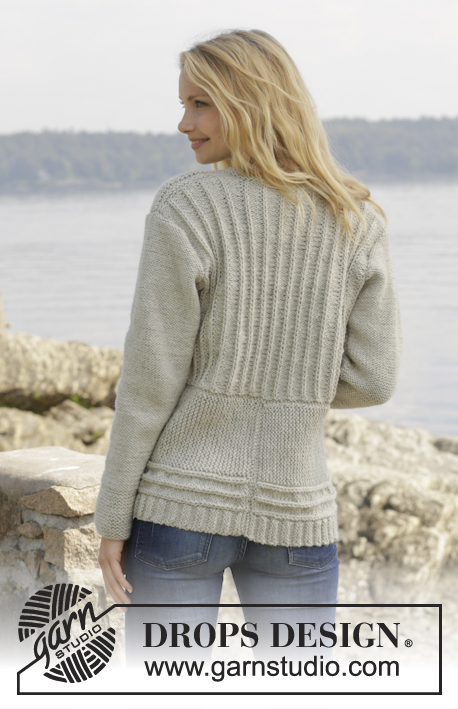 |
||||||||||||||||||
Knitted DROPS jacket with False English rib and short rows in "Nepal". Size S-XXXL
DROPS 157-25 |
|||||||||||||||||||
|
GARTER ST (back and forth on needle): K all rows. 1 ridge = K2 rows. PATTERN: See diagrams A.1-A.3. The diagram shows all rows in pattern seen from RS. INCREASE TIP (applies to sleeve): Inc inside 1 edge st in garter st and 1 P by making 1 YO. On next round work YO twisted, i.e. work in the back loop of st instead of front, to avoid holes. DECREASE TIP: Dec inside 1 edge st in garter st. All dec are done from RS! Dec before 1 edge st as follows: K 2 tog. Dec after 1 edge st as follows: Slip 1 st as if to K, K 1, psso. SHORT ROWS: Work short rows on front piece to get a rounded edge on the piece. Also work short rows between pattern A.2/A.3! Work short rows as follows with 1st row from RS: Row 1 and 2: Work 8 sts in all sizes, turn and work back. Row 3 and 4: Work 12 sts in all sizes, turn and work back. Row 5 and 6: Work 16 sts in all sizes, turn and work back. Row 7 and 8: Work 19-19-20-20-19-20 sts, turn and work back. Row 9 and 10: Work 21-21-23-23-21-23 sts, turn and work back. Continue to work 3 sts more on every turn until all sts have been worked. Repeat from 1st row a total of 5 times. (The rounded edge now measures approx. 28-31-34-37-41-46 cm / 11''-12¼''-13 3/8''-14½''-16''-18'' on the outer side and 3 cm / 1'' on the inside.) BUTTONHOLES: Dec for buttonholes on right band. 1 buttonhole = K tog second and third st from mid front and make 1 YO. Dec for buttonholes when piece measures (measured from the marker in the side): SIZE S: 1-8-15-22-29 cm / ½''-3''-6''-8¾''-11½'' SIZE M: 1-8-15-22-30 cm / ½''-3''-6''-8¾''-11¾'' SIZE L: 1-8-15-22-30 cm / ½''-3''-6''-8¾''-11¾'' SIZE XL: 1-8-16-23-31 cm / ½''-3''-6¼''-9''-12¼'' SIZE XXL: 1-8-16-23-31 cm / ½''-3''-6¼''-9''-12¼'' SIZE XXXL: 1-9-17-25-32 cm / ½''-3½''-6¾''-9¾''-12½'' ---------------------------------------------------------- JACKET: Worked back and forth in parts on circular needle and sewn tog when finished. BACK PIECE: Cast on 63-71-75-83-91-103 sts (includes 1 edge st in garter st in each side) on circular needle size 5 mm / US 8 with Nepal. Work 1 ridge in GARTER ST - see explanation above. Then work as follows: 1 edge st in garter st, A.1 (= 4 sts) until 2 sts remain on row, work 1st st in A.1, 1 edge st in garter st. Continue like this with pattern, AT THE SAME TIME when piece measures 4 cm / 1½'', inc inside 1 edge st in garter st in each side of piece by making 1 YO. On next row work YOs twisted to avoid holes, then P the new sts (seen from RS)! Repeat inc every 4-4-4-3-3-3 cm / 1½''-1½''-1½''-1¼''-1¼''-1¼'' 2-2-2-3-3-3 more times = 69-77-81-91-99-111 sts. REMEMBER THE GAUGE! When piece measures 20 cm / 8'' in all sizes, bind off for armholes each side as follows: bind off 3-4-5-6-7-8 sts 1 time and 1 st 1-3-3-6-7-11 times = 61-63-65-67-71-73 sts. Continue with pattern as before until piece measures 37-38-39-40-41-42 cm / 14½''-15''-15¼''-15¾''-16 1/8''-16½''. On next row from RS bind off for neck as follows: Work the first 21-22-22-23-24-25 sts, bind off the next 19-19-21-21-23-23 sts and work the remaining 21-22-22-23-24-25 sts. Then finish each shoulder separately as follows: Continue back over left shoulder and dec 1 st towards the neck on next row from RS = 20-21-21-22-23-24 sts for shoulder. When piece measures 38-39-40-41-42-43 cm / 15-15¼''-15¾''-16 1/8''-16½''-17'', work 1 ridge and loosely bind off. Work the other shoulder the same way. RIGHT EDGE PIECE/FRONT PIECE: Cast on 35-38-42-45-50-57 sts (includes 1 edge st in garter st) on circular needle size 5 mm / US 8 with Nepal. Work 1 ridge in garter st. Then work as follows from RS: Pattern A.3 (= 18 sts), 16-19-23-26-31-38 sts in garter st, 1 edge st in garter st. When piece measures approx. 18-21-23-24-26-30 cm / 7''-8¼''-9''-9½''-10¼''-11¾'', work SHORT ROWS - see explanation above, AT THE SAME TIME on last row in 1st repetition with short rows, inc 1 st by making a YO between A.3 and sts in garter st = 36-39-43-46-51-58 sts. Work YOs twisted on next row to avoid holes. Repeat inc on last row in the remaining repetitions of short rows 3-4-1-2-0-0 more times = 39-43-44-48-51-58 sts on needle. When all short rows have been worked, insert 1 marker. NOW MEASURE PIECE FROM HERE! Continue with garter st and pattern as before. Remember BUTTONHOLES - see explanation above. When piece measures 4 cm / 1½'', inc in the side as on back piece (i.e. the shorter side). After all inc, there are 42-46-47-52-55-62 sts on needle. When piece measures 20 cm / 8'', bind off for armhole in the side as on back piece (i.e in same side of piece as inc) = 38-39-39-40-41-43 sts. When piece measures 30-31-31-32-32-33 cm / 11¾''-12¼''-12¼''-12½''-12½''-13'', slip the first 9 sts on needle from RS on a stitch holder for neck. Then bind off sts as follows on every row from neck: 3 sts 1 time, 2 sts 2 times and 1 st 2 times = 20-21-21-22-23-25 sts remain for shoulder. When piece measures 38-39-40-41-42-43 cm / 15-15¼''-15¾''-16 1/8''-16½''-17'', work 1 ridge and bind off. LEFT EDGE PIECE/FRONT PIECE: Cast on and work as right edge piece/front piece but reversed. I.e. K 1 row from WS before working pattern like this: 1 edge st in garter st, 16-19-23-26-31-38 sts in garter st, A.2 over the remaining 18 sts on needle. Do not dec for buttonholes. SLEEVE: Worked back and forth on circular needle in reversed stockinette st. Cast on 42-42-44-44-46-48 sts (includes 1 edge st each side) on needle size 5 mm / US 8 with Nepal. Work 10 cm / 4'' in garter st. Continue with reversed stockinette st. On next row inc 1 st in each side of sleeve - Read INCREASE TIP! Repeat inc every 4-3-3-2½-2-2 cm / 1½''-1¼''-1¼''-1''-¾''-¾'' 8-10-10-12-13-14 more times = 60-64-66-70-74-78 sts. When piece measures 50-49-48-47-46-45 cm / 19¾''-19¼''-19''-18½''-18''-17¾'' (shorter measurements in the larger sizes because of longer sleeve cap and wider shoulders) bind off for sleeve cap at beg of every row in each side: 3 sts 1 time, 2 sts 3 times and 1 st 1-2-3-4-5-6 times, then bind off 2 sts in each side until piece measures 57 cm / 22½'', then bind off 3 sts 1 time in each side, bind off remaining sts. Piece measures approx. 58 cm / 22¾''. Make another sleeve. ASSEMBLY: Sew cast on edge on edge pieces tog mid back - sew edge to edge to avoid a chunky seam. Then sew edge piece to bottom edge of back piece. Sew the shoulder seams. Sew side seams and sleeve seams inside 1 edge st and sew sleeves in body. Sew the buttons on to the left band. NECK EDGE: Pick up approx. 72 sts (includes sts on stitch holders) around the neck. Work 2 ridges and bind off from WS. Cut and fasten the yarn. |
|||||||||||||||||||
Diagram explanations |
|||||||||||||||||||
|
|||||||||||||||||||

|
|||||||||||||||||||

|
|||||||||||||||||||

|
|||||||||||||||||||
|
Have you made this or any other of our designs? Tag your pictures in social media with #dropsdesign so we can see them! Do you need help with this pattern?You'll find tutorial videos, a Comments/Questions area and more by visiting the pattern on garnstudio.com. © 1982-2024 DROPS Design A/S. We reserve all rights. This document, including all its sub-sections, has copyrights. Read more about what you can do with our patterns at the bottom of each pattern on our site. |
|||||||||||||||||||
With over 40 years in knitting and crochet design, DROPS Design offers one of the most extensive collections of free patterns on the internet - translated to 17 languages. As of today we count 304 catalogs and 11422 patterns - 11417 of which are translated into English (US/in).
We work hard to bring you the best knitting and crochet have to offer, inspiration and advice as well as great quality yarns at incredible prices! Would you like to use our patterns for other than personal use? You can read what you are allowed to do in the Copyright text at the bottom of all our patterns. Happy crafting!






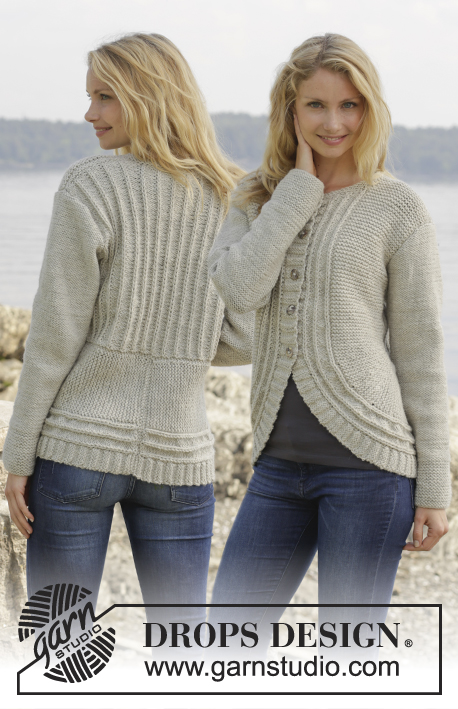
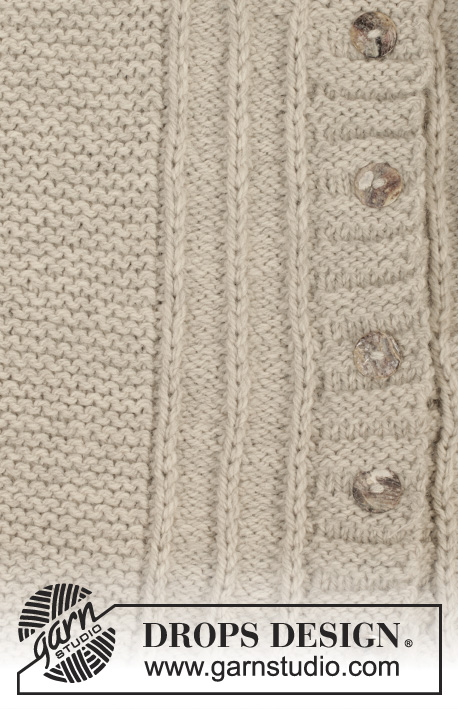


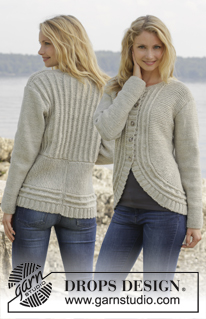















































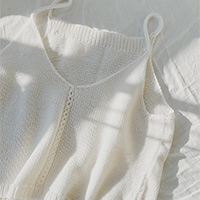




Comments / Questions (66)
I am knitting 2nd size when l have not got enough stitches. Should the 8 stitches for the front band be added to the 38 stitches needed to start this piece
18.11.2021 - 13:59DROPS Design answered:
Dear Mrs Ringham, in 2nd size you cast on 38 sts for edge/front piece and work as follows (right piece) A.3 (= 18 sts), 19 sts in garter st, 1 edge st in garter stitch = 18+19+1= 38 sts. Happy knitting!
19.11.2021 - 07:42Grazie per la spiegazione! ne chiedo un'ulteriore relativa agli INTRECCI per gli scalfi : devo intrecciare a diritto sul ferro a diritto e a rovescio sul ferro rovescio anche se in questo modello le maglie sono lavorate al contrario?
06.07.2020 - 10:55DROPS Design answered:
Buongiorno Giorgia. Per intrecciare, lavora le maglie come si presentano. In questo caso , ha maglie rov sul diritto del lavoro, quindi le chiude lavorandole a rovescio. Sul rovescio del lavoro ha maglie a diritto e le chiude lavorandole a diritto. Buon lavoro!
06.07.2020 - 16:45Problema col DIETRO TAGLIA M. Voi scrivete "lavorare come segue: 1 m di vivagno a m legaccio, A.1 (= 4 m) fino a quando rimangono 2 m sul f, lavorare la 1° m A.1...."perchè la mia penultima maglia risulta essere il gett. +maglia pass. ma il ferro successivo(FERRO ROVESCIO) prevede dopo la m di vivagno 3 m a diritto. Non riesco a capire ????
03.07.2020 - 19:03DROPS Design answered:
Buongiorno Giorgia. Al ferro successivo (sul rovescio) lavora 1 m vivagno, poi lavora il simbolo della prima maglia di A1, (quindi lavora insieme a rov la gettata e la maglia passata), poi 3 maglie diritto e così via in modo che il motivo sia allineato correttamente. Buon lavoro!
03.07.2020 - 22:33Innanzitutto vi ringrazio per le celere risposta e per mettere a nostra disposizione questi splendidi modelli, ma non riesco proprio a capire cosa significhi "lavorare 1 ferro diritto dal rovescio del lavoro"..
19.06.2020 - 16:34DROPS Design answered:
Buongiorno Giorgia. Sul davanti sinistro, per iniziare a lavorare il diagramma sul diritto del lavoro (parte del lavoro che si vede quando indossato) è necessario lavorare un ferro a diritto sulla parte del lavoro che rimane all'interno quando il capo è indossato (parte che nelle spiegazione viene indicata come rovescio del lavoro). Buon lavoro!
19.06.2020 - 18:21Quando si inizia il davanti sinistro in modo speculare a quello destro non riesco a capire quando scrivete :"Cioè lavorare 1 f dir dal rovescio del lavoro prima di lavorare il motivo". Dopo aver avviato il numero di maglie necessario alla mia taglia e fatta 1 costa a legaccio, cosa devo fare? Lavoro il ferro seguente tutto a rovescio e poi il successivo ferro lo lavoro seguendo lo schema A2?
19.06.2020 - 08:08DROPS Design answered:
Buongiorno Giorgia, deve lavorare 1 costa a legaccio, 1 ferro diritto dal rovescio del lavoro e poi inizia a lavorare il motivo come indicato.
19.06.2020 - 15:48I love this pattern having just purchased it can it be worked on two needles instead of a circular one thank you
02.10.2019 - 15:31DROPS Design answered:
Dear Mrs Long, this pattern is worked in different pieces worked back and forth on circular needle to get enough room for all stitches, you can here use straight needles instead. Read more here about circular needles. Happy knitting!
02.10.2019 - 16:01Hallo ich bin gerade beim rechten Vorderteil mit den verkürtzten Reihen fertig,nun heißt es Markierer anbringen die Arbeit wird von hier gemessen. Nun meine Frage: wird die Arbeit an der Blende gemessen oder an der kraus rechten Seite wo die Arbeit ja kürzer ist.? Würde mich über Antwort freuen damit ich weiterstricken kann 😊,lg
13.04.2019 - 10:58DROPS Design answered:
Liebe Nicole, jetzt messen Sie an der rechten Seite bzw vom Ende den verkürzten Reihen - siehe auch Maßskizze. Viel Spaß beim stricken!
23.04.2019 - 09:33It\'s a very nice pattern and is well explained. Thanks again
29.03.2019 - 05:47Guten Abend,\r\nich verstehe diese Anleitung überhaupt nicht! Wieviele Maschen muss ich anschlagen für Größe XL, 83 oder 85? Und was bedeutet diese Strickrichtung?? Auf mich wirkt diese Anleitung durcheinander und unübersichtlich! Schade.\r\nIch habe schöne Stücke mit Drops gestrickt....\r\nMalika
07.12.2018 - 21:30DROPS Design answered:
Liebe Frau Raduenz, in der Größe XL schlagen Sie für den Rückenteil 83 M. Rückenteil ist von unten nach oben gestrickt. Dann stricken Sie die beiden Vorderteilen, die zuerst quer von der Mitte Rückenteil gestrickt sind (siehe Pfeil und Sternchen in der Maßskizze), dann stricken Sie die verkürtzten Reihen (gestrichelten Linien) und dann von unten nach oben. Viel Spaß beim stricken!
10.12.2018 - 11:08So I've come back to this project having got stuck at the start the short rows in size M. I understand how to go through the short rows, but the description says to 'work short rows as follows' do I continue with the existing pattern or do I just knit and purl the short rows? My 1st row from the RS starts on the 7 rib sts. Thank you
14.08.2018 - 16:54DROPS Design answered:
Dear Caroline, the short rows on front pieces are worked in pattern, starting with the 8 first sts from RS, ie 8 sts in A.3 on right edge/front piece - start reading diagram from RS on the bottom corner on the right side towards the left -and from the left towards the right from WS). Happy knitting!
16.08.2018 - 08:48